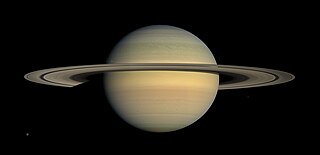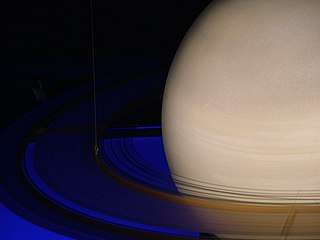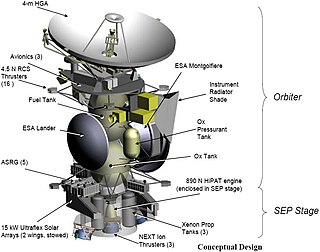Related Research Articles

Saturn is the sixth planet from the Sun and the second-largest in the Solar System, after Jupiter. It is a gas giant with an average radius of about nine and a half times that of Earth. It only has one-eighth the average density of Earth; however, with its larger volume, Saturn is over 95 times more massive.

Titan is the largest moon of Saturn and the second-largest natural satellite in the Solar System. It is the only moon known to have a dense atmosphere, and is the only known object in space other than Earth on which clear evidence of stable bodies of surface liquid has been found.

The Cassini–Huygens space-research mission, commonly called Cassini, involved a collaboration among NASA, the European Space Agency (ESA), and the Italian Space Agency (ASI) to send a space probe to study the planet Saturn and its system, including its rings and natural satellites. The Flagship-class robotic spacecraft comprised both NASA's Cassini space probe and ESA's Huygens lander, which landed on Saturn's largest moon, Titan. Cassini was the fourth space probe to visit Saturn and the first to enter its orbit, where it stayed from 2004 to 2017. The two craft took their names from the astronomers Giovanni Cassini and Christiaan Huygens.

Huygens was an atmospheric entry robotic space probe that landed successfully on Saturn's moon Titan in 2005. Built and operated by the European Space Agency (ESA), launched by NASA, it was part of the Cassini–Huygens mission and became the first spacecraft to land on Titan and the farthest landing from Earth a spacecraft has ever made. The probe was named after the 17th-century Dutch astronomer Christiaan Huygens, who discovered Titan in 1655.

This article provides a timeline of the Cassini–Huygens mission. Cassini was a collaboration between the United States' NASA, the European Space Agency ("ESA"), and the Italian Space Agency ("ASI") to send a probe to study the Saturnian system, including the planet, its rings, and its natural satellites. The Flagship-class uncrewed robotic spacecraft comprised both NASA's Cassini probe, and ESA's Huygens lander which was designed to land on Saturn's largest moon, Titan. Cassini was the fourth space probe to visit Saturn and the first to enter its orbit. The craft were named after astronomers Giovanni Cassini and Christiaan Huygens.

Xanadu is a highly reflective area on the leading hemisphere of Saturn's moon Titan. Its name comes from an alternate transcription of Shangdu, the summer capital of the Yuan dynasty established by Kublai Khan and made famous by Samuel Taylor Coleridge.

Mariner Mark II was NASA's planned family of unmanned spacecraft for the exploration of the outer Solar System that were to be developed and operated by JPL between 1980 through the year 2010.
Jean-Pierre Lebreton is a French planetary scientist at ESA, specialized in plasma physics. He was the mission manager of the Huygens probe that landed on Saturn's moon Titan in 2005. Besides the Huygens mission, Lebreton is also working with the Rosetta comet probe and its Plasma Consortium Experiment, and the Venus Express space probe.

Jan Charles "John" Zarnecki, is an English space science professor and researcher. Since 2013, Zarnecki has been a Director of the International Space Science Institute. Between 2004 and 2013 he was a Professor of Space Science at the Open University, having previously been a professor and researcher at the University of Kent.

The exploration of Saturn has been solely performed by crewless probes. Three missions were flybys, which formed an extended foundation of knowledge about the system. The Cassini–Huygens spacecraft, launched in 1997, was in orbit from 2004 to 2017.

The atmosphere of Titan is the dense layer of gases surrounding Titan, the largest moon of Saturn. It is the only thick atmosphere of a natural satellite in the Solar System. Titan's lower atmosphere is primarily composed of nitrogen (94.2%), methane (5.65%), and hydrogen (0.099%). There are trace amounts of other hydrocarbons, such as ethane, diacetylene, methylacetylene, acetylene, propane, PAHs and of other gases, such as cyanoacetylene, hydrogen cyanide, carbon dioxide, carbon monoxide, cyanogen, acetonitrile, argon and helium. The isotopic study of nitrogen isotopes ratio also suggest acetonitrile may be present in quantities exceeding hydrogen cyanide and cyanoacetylene. The surface pressure is about 50% higher than on Earth at 1.5 bars which is near the triple point of methane and allows there to be gaseous methane in the atmosphere and liquid methane on the surface. The orange color as seen from space is produced by other more complex chemicals in small quantities, possibly tholins, tar-like organic precipitates.

Titan Saturn System Mission (TSSM) was a joint NASA–ESA proposal for an exploration of Saturn and its moons Titan and Enceladus, where many complex phenomena were revealed by Cassini. With an estimated NASA cost of $2.5 billion (FY07), TSSM was proposed to launch in 2020, get gravity assists from Earth and Venus, and arrive at the Saturn system in 2029. The 4-year prime mission would include a two-year Saturn tour, a 2-month Titan aero-sampling phase, and a 20-month Titan orbit phase.

Titan Mare Explorer (TiME) is a proposed design for a lander for Saturn's moon Titan. TiME is a relatively low-cost, outer-planet mission designed to measure the organic constituents on Titan and would have performed the first nautical exploration of an extraterrestrial sea, analyze its nature and, possibly, observe its shoreline. As a Discovery-class mission it was designed to be cost-capped at US$425 million, not counting launch vehicle funding. It was proposed to NASA in 2009 by Proxemy Research as a scout-like pioneering mission, originally as part of NASA's Discovery Program. The TiME mission design reached the finalist stage during that Discovery mission selection, but was not selected, and despite attempts in the U.S. Senate failed to get earmark funding in 2013. A related Titan Submarine has also been proposed.

David John Southwood is a British space scientist who holds the post of Senior Research Investigator at Imperial College London. He was the President of the Royal Astronomical Society from 2012–2014, and earlier served as the Director of Science and Robotic Exploration at the European Space Agency (2001–2011). Southwood's research interests have been in solar–terrestrial physics and planetary science, particularly magnetospheres. He built the magnetic field instrument for the Cassini Saturn orbiter.

The Cassini space probe was deliberately disposed of via a controlled fall into Saturn's atmosphere on September 15, 2017, ending its nearly two-decade-long mission. This method was chosen to prevent biological contamination of any of the moons of Saturn now thought to offer potentially habitable environments. Factors that influenced the mission end method included the amount of rocket fuel left, the health of the spacecraft, and funding for operations on Earth.

A flyby is a spaceflight operation in which a spacecraft passes in proximity to another body, usually a target of its space exploration mission and/or a source of a gravity assist to impel it towards another target. Spacecraft which are specifically designed for this purpose are known as flyby spacecraft, although the term has also been used in regard to asteroid flybys of Earth for example. Important parameters are the time and distance of closest approach.

Athena Coustenis is an astrophysicist specializing in planetology. Dr. Coustenis, a French national, is director of research, Centre national de la recherche scientifique, at LESIA, at the Paris Observatory, Meudon. She is involved in several space mission projects for the European Space Agency (ESA) and for NASA. Her focus is on gas giant planets Saturn, Jupiter and their moons, and she is considered a foremost expert on Saturn's moon Titan.
Ralph D. Lorenz is a planetary scientist and engineer at the Johns Hopkins Applied Physics Lab. whose research focuses on understanding surfaces, atmospheres, and their interactions on planetary bodies, especially Titan, Venus, Mars, and Earth. He currently serves as Mission Architect of Dragonfly, NASA's fourth selected New Frontiers mission, and as participating scientist on Akatsuki and InSight. He is a Co-Investigator on the SuperCam instrument on the Perseverance rover, responsible for interpreting data from its microphone. He leads the Venus Atmospheric Structure Investigation on the DAVINCI+ Discovery mission to Venus. He is the recipient of the 2020 International Planetary Probe Workshop (IPPW) Al Seiff memorial award.
References
- ↑ Oberg, James (October 4, 2004). "Titan Calling: How a Swedish engineer saved a once-in-a-lifetime mission to Saturn's mysterious moon". IEEE Spectrum.
ESA's staff association awarded him and some of his colleagues a plaque and a small cash prize for their role in saving the $300 million mission [US$300,000,000(equivalent to about $411,000,000 in 2020)], though Smeds told Spectrum that he is still looking forward to his real reward: "I hope to sit in Darmstadt and see the data coming in on the screen in January."
(offline as of 2006-10-14, see Internet Archive version) - ↑ "The Story Behind "Titan Calling" | The Back Story". IEEE Spectrum: Technology, Engineering, and Science News. 1 October 2004. Archived from the original on 2012-09-27. Retrieved 2020-02-24.
When James Oberg [..] suggested to IEEE Spectrum an article[...]As the research for this article progressed, we discovered another reason to print it: the tale of an unsung hero, Boris Smeds. Without him, Huygens's mission would have continued in ignorance of the lurking communications problem—right up until disaster. Smeds's commitment to uncompromising engineering led him to battle bureaucracy and develop the tough test that unmasked the flaw. His engineering instinct and ability to improvise rooted out not just the flaw's existence, but its proximate cause. Smeds's example of what it means to be a great engineer is the most compelling lesson of all.